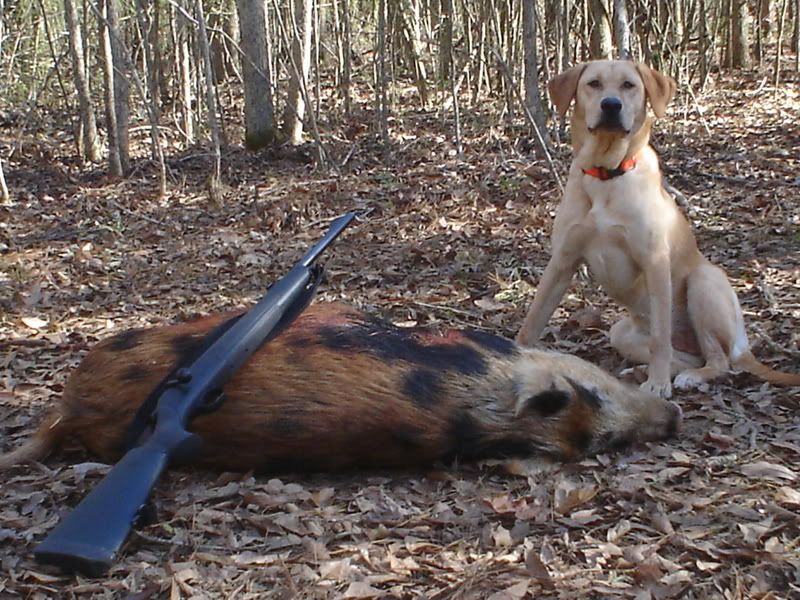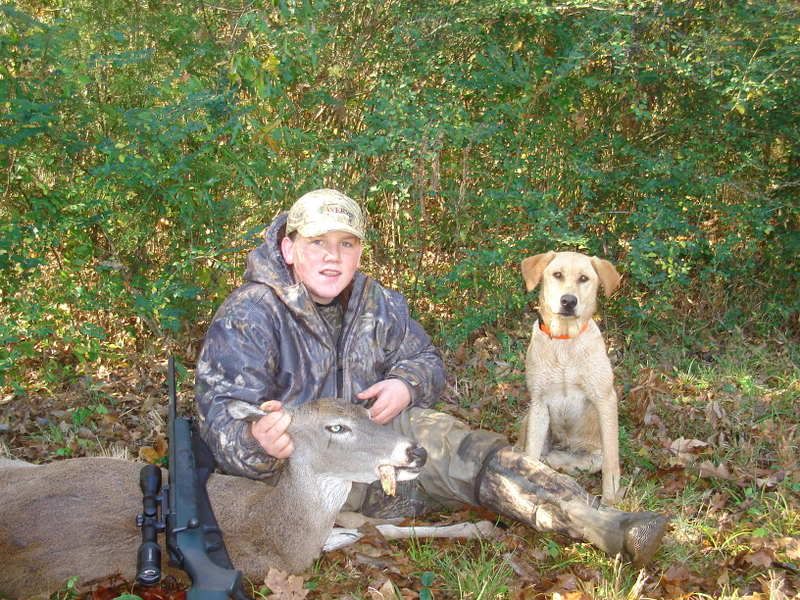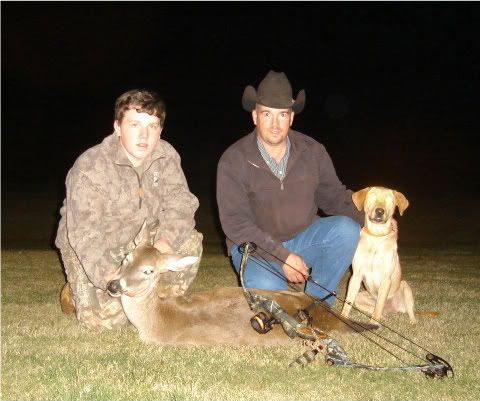Techniques For Finding Wounded Deer?
#11
The problem with the land I hunt is that it is primarily swamp. If you have never tracked a deer in swamps it can be ridiculous. The deer in my avitar ran about 80 into this swamp after I shot him. It took me and a buddy of mine 2 hours to find him. We might have got a drop that landed on a leaf every 20 feet. We just looked at the ground and how to mud was turned up and followed it. We got to splits and trails and like iSnipe said we followed the one we thought of first. I have never lost a deer that I shot but I have tracked some that were never found.
#12
I have been on alot of bloodtrails with friends, family, and by myself. I only look for blood, mark it with toilet paper, until I find the deer. I have a knack for finding blood and downed game, so everyone seems to call me ( I actually get a kick out of blood trailing deer). When the blood trail stops I go pick up two of my deer dogs and they usually find them quickly- but I save the dogs for very last because I like to blood trail.
A good deer dog/ blood tracking dog is very reliable and easily the best way to find a deer. No human blood tracker can ever compare to a experienced nose of a dog....
A good deer dog/ blood tracking dog is very reliable and easily the best way to find a deer. No human blood tracker can ever compare to a experienced nose of a dog....
#13
I always start with the hit site and then mark the blood trail with TP or flagging tapes. If the blood runs out I see the trend of the trail and try to continue to follow the trail. If that fails I do a grid search. Most of the time I recover the Animal but often they are holed up in a thicket or blow down.
#14
Nontypical Buck
Join Date: Feb 2005
Location:
Posts: 1,785
Here is how I find wounded deer and hogs. I shot this hog at night, and Annie found it 16 hours after the shot. Annie trailed the doe about a quarter of a mile and had to cross a stream to find her. Annie tracked the bow doe for about a 100 yards in the dark with no visible blood other than where the doe was hit.
Annie is only 19 months old, but she has already proved to be invaluable to me.



Annie is only 19 months old, but she has already proved to be invaluable to me.



#17
I bought one and paid too much for it (shop around). I'm a little colorblind and I hoped it would help. I helped track a buddy's doe after dark and it wasn't much better. A really bright light is probably best.
#18
I believe persistence is the biggest factor in recovering a wounded deer. I honestly believe many hunters give up too soon. Marking blood sign is always important as well, especially if the blood trail appears to end. That's the time to get on your hands and knees and begin turning over leaves for any evidence of blood. I never 'trust' anything when looking for a wounded deer. By that I mean, just because there is little or no blood, does not mean the deer was not hit hard. We have found deer that, at times, appeared a hopeless cause, because we never gave up and discovered the deer had massive internal bleeding.
Having a few other hunters help can certainly be beneficial but care must be taken here. We always ensure we don't 'trash' the area looking for sign. Also, many hunters are more focused on looking for blood than the actual deer. As obvious as this may sound, you must always keep your head looking up for that deer. Plus, I always check areas that a rabbit may try to hide. A wounded deer will sometimes lay in the thickest, nastiest stuff many hunters will fail to look.
Good advice has been given here to a great thread. Getting valuable input from other hunters is always beneficial.
Having a few other hunters help can certainly be beneficial but care must be taken here. We always ensure we don't 'trash' the area looking for sign. Also, many hunters are more focused on looking for blood than the actual deer. As obvious as this may sound, you must always keep your head looking up for that deer. Plus, I always check areas that a rabbit may try to hide. A wounded deer will sometimes lay in the thickest, nastiest stuff many hunters will fail to look.
Good advice has been given here to a great thread. Getting valuable input from other hunters is always beneficial.
#19
Banned
Join Date: Dec 2009
Posts: 77
we always stay behind the last spot of blood, then proceed when you find the next spot.
I believe persistence is the biggest factor in recovering a wounded deer. I honestly believe many hunters give up too soon. Marking blood sign is always important as well, especially if the blood trail appears to end. That's the time to get on your hands and knees and begin turning over leaves for any evidence of blood. I never 'trust' anything when looking for a wounded deer. By that I mean, just because there is little or no blood, does not mean the deer was not hit hard. We have found deer that, at times, appeared a hopeless cause, because we never gave up and discovered the deer had massive internal bleeding.
Having a few other hunters help can certainly be beneficial but care must be taken here. We always ensure we don't 'trash' the area looking for sign. Also, many hunters are more focused on looking for blood than the actual deer. As obvious as this may sound, you must always keep your head looking up for that deer. Plus, I always check areas that a rabbit may try to hide. A wounded deer will sometimes lay in the thickest, nastiest stuff many hunters will fail to look.
Good advice has been given here to a great thread. Getting valuable input from other hunters is always beneficial.
Having a few other hunters help can certainly be beneficial but care must be taken here. We always ensure we don't 'trash' the area looking for sign. Also, many hunters are more focused on looking for blood than the actual deer. As obvious as this may sound, you must always keep your head looking up for that deer. Plus, I always check areas that a rabbit may try to hide. A wounded deer will sometimes lay in the thickest, nastiest stuff many hunters will fail to look.
Good advice has been given here to a great thread. Getting valuable input from other hunters is always beneficial.
#20
Wow gentleman, I'm impressed! Posts came rolling in with some very good ideas. Everyone put down some good information we all can consider and add to our own repertoire or bag of tracking tips!
I must say, a few posts caught my eye. The first was from 7.62NATO, where he suggests:
"WAIT for at least 30 minutes before trying to track a wounded deer"
This I believe is where trouble starts for many of us. Through the excitement, etc, we often take to the trail too fast and bump the deer that should have been given more time to expire. Sometimes we may witness a bad hit, like far back liver or possible gut shot, then we should consider waiting up to 6 hours or more.
The next tidbit of advice comes from zrexpilot when he explains:
"biggest tip is knowing exactly, and I mean exactly where he was standing at the time of the shot."
I find this to be vital, because while some may feel it isn't that important if you skip to where you last saw the deer and start trailing from there, but you miss something in that process.
If you do as zrexpilot suggests, the exact spot where the deer was standing, can lead to some crucial evidence. One can maybe identify what part of the deer was struck by what the blood looks like there, what kind of hair was found and if there are bone fragments or tallow/fat at the scene. This info can better give you an idea of shot placement and how to track accordingly.
The biggest tip of all, for me anyway, hits on something I value in life, and that is the tip offered up by Jimmy S. as he says:
"I believe persistence is the biggest factor in recovering a wounded deer. I honestly believe many hunters give up too soon."
I too believe in persistence... BIG TIME! The reasons are obvious, but I've learned a person can achieve big things if they don't give up and keep being persistent.
Great info guys! A post filled with info we can all learn from.
Thank you very much!
iSnipe
I must say, a few posts caught my eye. The first was from 7.62NATO, where he suggests:
"WAIT for at least 30 minutes before trying to track a wounded deer"
This I believe is where trouble starts for many of us. Through the excitement, etc, we often take to the trail too fast and bump the deer that should have been given more time to expire. Sometimes we may witness a bad hit, like far back liver or possible gut shot, then we should consider waiting up to 6 hours or more.
The next tidbit of advice comes from zrexpilot when he explains:
"biggest tip is knowing exactly, and I mean exactly where he was standing at the time of the shot."
I find this to be vital, because while some may feel it isn't that important if you skip to where you last saw the deer and start trailing from there, but you miss something in that process.
If you do as zrexpilot suggests, the exact spot where the deer was standing, can lead to some crucial evidence. One can maybe identify what part of the deer was struck by what the blood looks like there, what kind of hair was found and if there are bone fragments or tallow/fat at the scene. This info can better give you an idea of shot placement and how to track accordingly.
The biggest tip of all, for me anyway, hits on something I value in life, and that is the tip offered up by Jimmy S. as he says:
"I believe persistence is the biggest factor in recovering a wounded deer. I honestly believe many hunters give up too soon."
I too believe in persistence... BIG TIME! The reasons are obvious, but I've learned a person can achieve big things if they don't give up and keep being persistent.
Great info guys! A post filled with info we can all learn from.
Thank you very much!

iSnipe


